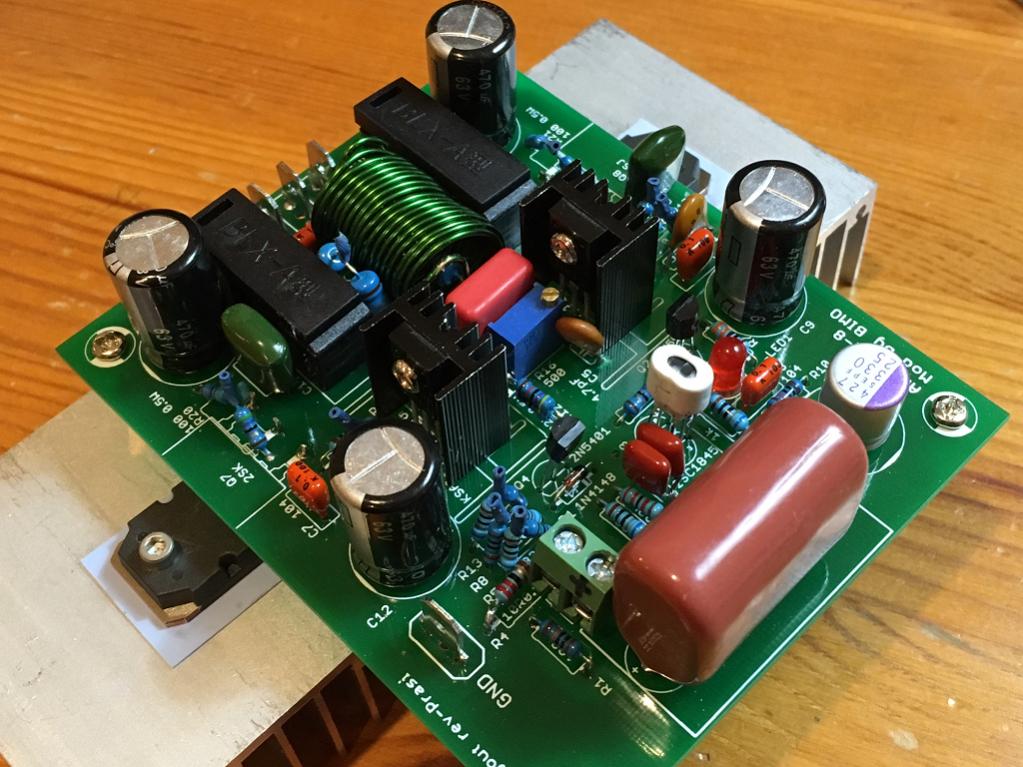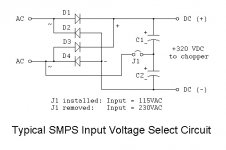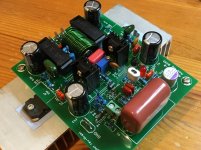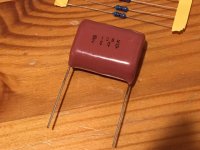This looks very interesting.
Is there more details available regarding the transformer?
what kind of core, number of turns, etc...
Transformers is from ATX PSU without rewind.
I knew there would be interest in a low cost Apex style DIY SMPS with 35 or 40v rails. What we need to do is add linear-style (shunt) regulation to the SMPS. Make it over voltage at say 40v - go through some CLC filters, and then shunt regulate with a MOSFET and zener stack or a TL431 and a driver... Sort of the best of both worlds?
I knew there would be interest in a low cost Apex style DIY SMPS with 35 or 40v rails. What we need to do is add linear-style (shunt) regulation to the SMPS. Make it over voltage at say 40v - go through some CLC filters, and then shunt regulate with a MOSFET and zener stack or a TL431 and a driver... Sort of the best of both worlds?
Output voltage is not +/-50V... more about +/-30-40V... Use some transformer with about 60vac output and test smps, do not connect to main supply before 60vac test.
I knew there would be interest in a low cost Apex style DIY SMPS with 35 or 40v rails. What we need to do is add linear-style (shunt) regulation to the SMPS. Make it over voltage at say 40v - go through some CLC filters, and then shunt regulate with a MOSFET and zener stack or a TL431 and a driver... Sort of the best of both worlds?
Shunt regulator for power amp PSU?
Good for cold winter nights....
Most SMPS won't like running into a CLC bank.
These that I've been using don't like anything bigger than 1000uF
Shunts are used all the time in high end class A amps. Isn't it the only way to get clean clean supplies? Anyhow I was thinking it just needs to burn off say 5 volts from 40 to 35.
Maybe RCLC 🙂
But if it all turns out to be such a hassle of expensive maybe just go back to the 10lb 250va toroid?
I am hoping the parts to the SMPS are like $10.
Maybe RCLC 🙂
But if it all turns out to be such a hassle of expensive maybe just go back to the 10lb 250va toroid?
I am hoping the parts to the SMPS are like $10.
Last edited:
Shunts are used all the time in high end class A amps. Isn't it the only way to get clean clean supplies? Anyhow I was thinking it just needs to burn off say 5 volts from 40 to 35.
Maybe RCLC 🙂
But if it all turns out to be such a hassle of expensive maybe just go back to the 10lb 250va toroid?
I am hoping the parts to the SMPS are like $10.
I'm using 700W SMPS for big power amp.
The total cost was $150.00 for two of them, including shipping (from Jordan). Works great, smaller and cheaper than toroid + caps.
Guy that runs http://www.diysmps.com makes/sells them.
https://www.flickr.com/photos/danielminek/25994440043/in/album-72157667323114622/
Last edited:
I can't see a voltage doubler. They both look the same to me, except for that Mains AC link.
Does that link create a voltage doubler?
Attachments
Post 7509 makes sense but I don't see any "jumper" missing or otherwise in the 110v and 220v schematics that Apex posted - they are identical other than the label that
says 110v or 220v. Am I missing something?
says 110v or 220v. Am I missing something?
Post 7509 makes sense but I don't see any "jumper" missing or otherwise in the 110v and 220v schematics that Apex posted - they are identical other than the label that
says 110v or 220v. Am I missing something?
There is a line (connection) added between one of AC mains to
the junction between capacitors C2 and C3.
Post 7509 makes sense but I don't see any "jumper" missing or otherwise in the 110v and 220v schematics that Apex posted - they are identical other than the label that
says 110v or 220v. Am I missing something?
Maybe...
Attachments
In case of a 110-220V variable input power supply, one must be aware that "TRAFO" must withstand 220 volts! A DPDT switch can do the job for both situations (voltage doubling and TRAFO selection).
Since last photo: 18 ga magnet wire (18 loops), 10uF Panasonic 250v film cap on input, heatsinks on VAS transistors.

nice job!, what abt listening impressions? also any difficulties in build?
reg
Prasi
Last edited:
The FX8 Bimo - and I only have one so far so cannot listen to it in stereo, sounds very very good. It has the FX8 signature of excellent transparency combined with powerful bass authority. I need to build the second unit but I can say it is very similar to the FX8 50mm. I swapped one channel of the stereo FX8 50mm for the Bimo, and really could not tell the difference with my ear. I will wait for a stereo pair before a full assessment can be made.
This build was easy - this is a great PCB that is feature loaded: fuse holders, room for heat sinks in VAS, and large input capacitors of various sizes are accommodated. It's a very roomy board compared to the 50mm FX8 which is almost 4 times smaller.
This build was easy - this is a great PCB that is feature loaded: fuse holders, room for heat sinks in VAS, and large input capacitors of various sizes are accommodated. It's a very roomy board compared to the 50mm FX8 which is almost 4 times smaller.
10uF Panasonic 250v film cap
Is the Panasonic a MKT cap or MKP?
Thanks...
Is the Panasonic a MKT cap or MKP?
Thanks...
I am not sure maybe someone can tell me. I am guessing it is metalized polypropylene film. Here is photo.
Attachments
the "H" code probably means something if you know the manufacturer.
the 250 G is probably voltage
106 k is 10 * 10^6 pF = 10uF and K = ±10%
I suspect this is MKS/MKT/Mylar/Polyester
the 250 G is probably voltage
106 k is 10 * 10^6 pF = 10uF and K = ±10%
I suspect this is MKS/MKT/Mylar/Polyester
the "H" code probably means something if you know the manufacturer.
the 250 G is probably voltage
106 k is 10 * 10^6 pF = 10uF and K = ±10%
I suspect this is MKS/MKT/Mylar/Polyester
You are right. It's polyester. Polypropilene would be much bigger.
- Home
- Amplifiers
- Solid State
- 100W Ultimate Fidelity Amplifier



